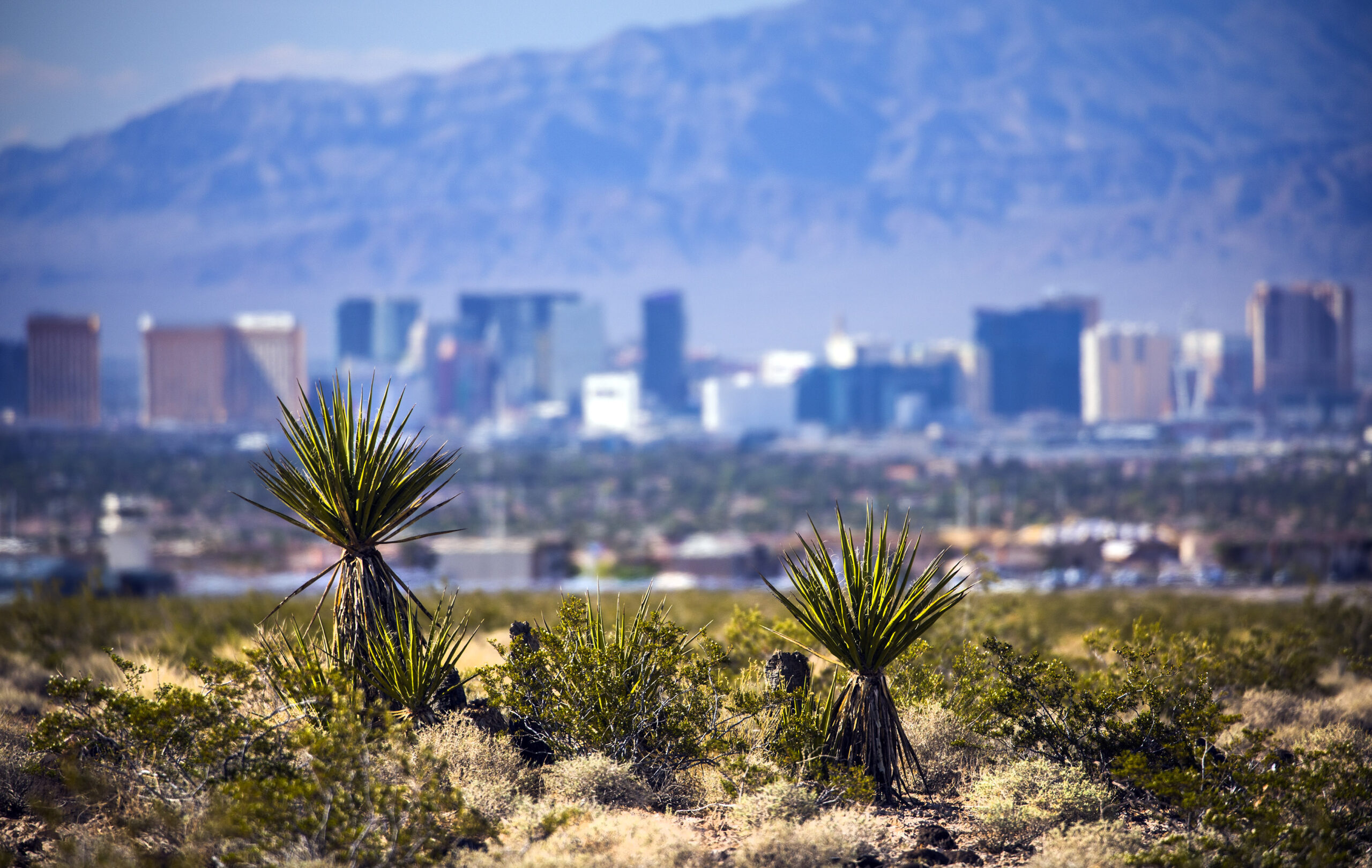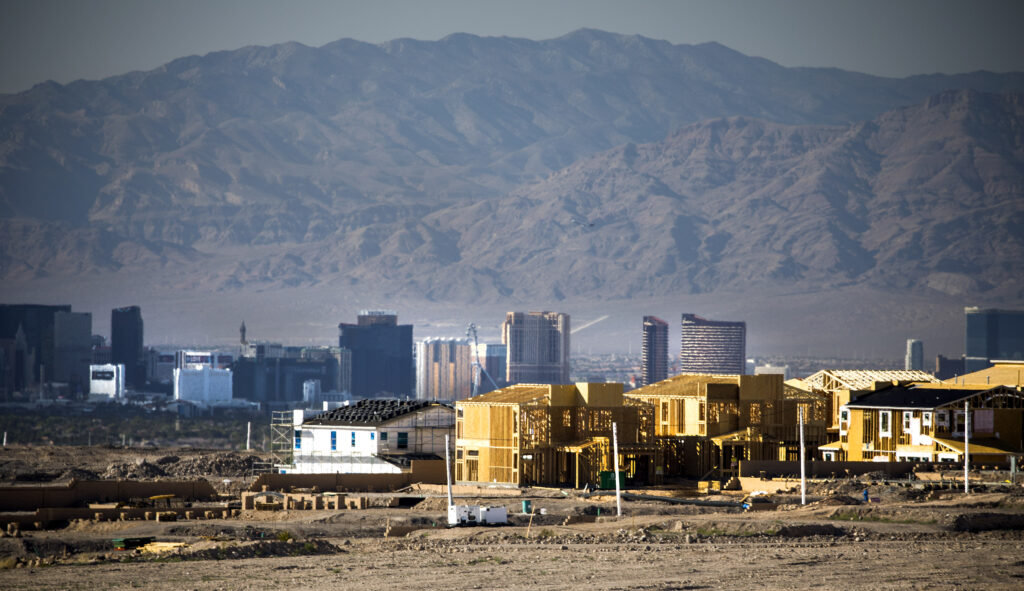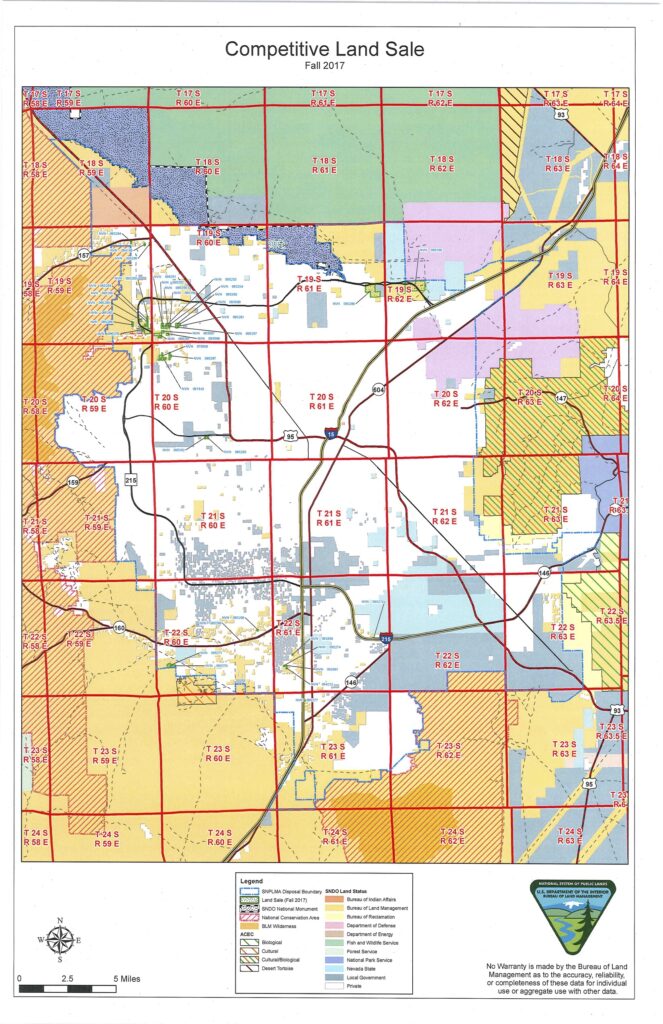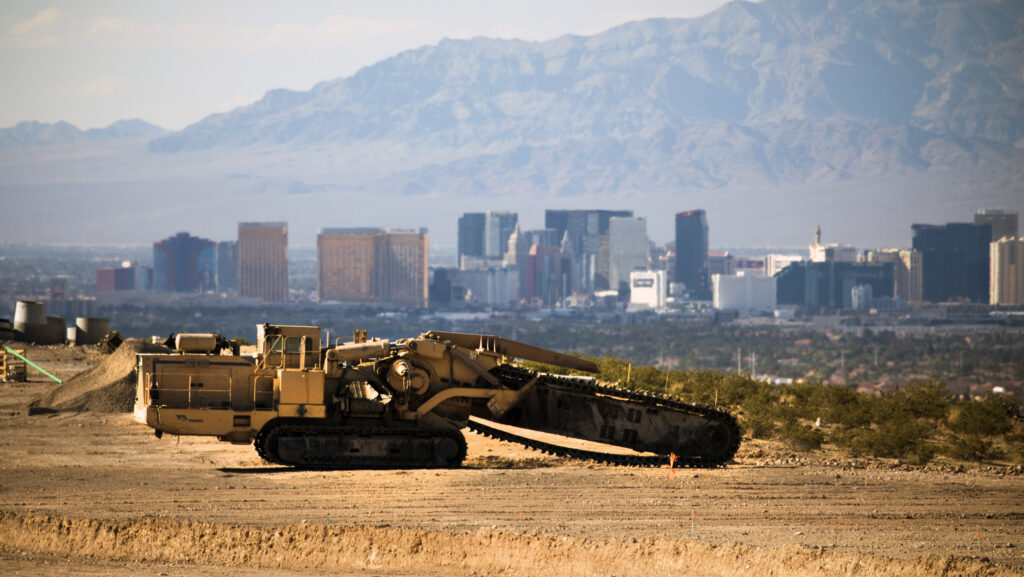With public lands bill on the table, should Las Vegas grow out or grow up?

When commercial developer Mike Mixer tours potential buyers around Southern Nevada to show them the real estate market, he often hears the same question: “What’s the problem?”
Then they’ll say, according to Mixer, “I see lots of land as far as the eye can see.”
Like a mirage in the desert, Mixer tells them, it’s an illusion: Las Vegas needs more land.
Mixer, the regional chapter president of NAIOP, the Commercial Real Estate Development Association, said he generally supports the county’s push to expand developable land by roughly 38,000 acres. If Clark County’s land proposal moves forward, it would extend the boundaries of growth along the I-15 corridor and toward California. What sits in that area right now is federal public land managed by the Bureau of Land Management, the agency that oversees 67 percent of Nevada’s land. As a result, opening up land to development will require an act of Congress.
Supporters argue that the move could ease land costs for developers, reining in land prices for prospective homeowners or companies that want to build in the Las Vegas Valley, but it could also worsen sprawl and the pressures it can place on water, air quality, wildlife, even inequality.
And it raises a question that has dogged Las Vegas and other Western cities for years, cities that have grown around the car and the highway: Should the city grow outward or upward?
Patrick Donnelly, state director for the Center of Biological Diversity, described the proposal as a Rubicon moment for Las Vegas, a move that could open up even more public land in the future.
“Are we going to turn into Phoenix?” he asked.
The debate comes as two county commissioners, Chris Giunchigliani and Steve Sisolak, face off against each other in the Democratic primary for governor. Development has recently become a heated issue in the campaign, with Giunchigliani running an ad against Sisolak for supporting a controversial home development near Red Rock National Conservation Area after receiving a donation from the developer behind the project. Another county commissioner, Susan Brager, fired back in defense of Sisolak, calling Giunchigliani’s claim “disingenuous” and “shameful.”
When it comes to the question of whether Las Vegas should grow outward or grow up vertically, Sisolak, who chairs the County Commission, said he supports an all-of-the-above approach.
“[Las Vegas] needs to grow out and it needs to grow up,” Sisolak said.
Giunchigliani took a more cautious approach, suggesting the county should first start with a needs assessment and reform some of the zoning issues across the different municipalities.
“We have to look at what resources we have,” Giunchigliani said.
The primary is on June 12. County staff are planning to bring the lands proposal to a possible vote before the commission on June 19, where the resolution will have its first public hearing.

There’s no way to talk about land policy in Southern Nevada without bringing up the complex law known by its clunky acronym, SNPLMA. Congress approved the Southern Nevada Public Land Management Act in 1998 and created a program to organize sales of public BLM land to developers. It created a “disposal boundary” around the Las Vegas Valley, placing a de facto limit on what land developers and local governments could purchase or reserve for projects.
“The origins of that initiative were good,” Mixer said. “It allowed a defined boundary of steady, orderly disposal of BLM land within that boundary line. There was a lot of land in there that needed to get out, and it created a process that worked. What we’re trying to illuminate is that now it’s time to go beyond that original boundary and talk about additional growth areas.”
Mixer said much of the land is claimed, one way or another. Some of the land within the urban areas is private. Other land might be BLM-owned and fall outside of the disposal boundary. Other land might be good for commercial or urban homes but zoned for rural projects. Other parcels might be vacant but locked in too small of a space to stoke a developer’s interest.
Mixer, who focuses on commercial real estate as a co-founder of the Colliers International Las Vegas office, said the limits have and will continue to increase the price of available parcels. It’s turned some developers away, he said. Instead of Las Vegas, they opt for places like Phoenix, Denver or Southern California, where he argued there is more supply and cheaper land.
“If I was to take you on a tour in my office on an aerial map of the valley, I could show you just how much federally-owned land is shaded versus privately-owned land,” Mixer said. “You would understand that we really are constrained from a growth perspective, in terms of residential growth, commercial growth or industrial growth. It’s really apparent when you see it.”

That’s where the Clark County plan would come in.
The plan has not been introduced to the public but the negotiations surrounding it are already complicated, involving diverse interests, including developers, conservationists, utilities and federal land managers. A draft of the plan, in the form of a resolution calling on Congress to pass legislation, is the product of private meetings that have dragged on for nearly a year.
County commissioners were going to vote on it last August, according to an agenda, but it was pulled so negotiations could continue. Since then, the vote has been a moving target. It was going to go up for a vote earlier this year, but it was scrapped again so that work could continue on the plan.
Marci Henson, the county’s director of air quality and the point-person on the public lands bill planning, said the expansion of land is needed to meet a growing population. The additional land would more than double the amount of real estate that the BLM can currently sell to private developers and cities under the Southern Nevada Public Land Management Act (SNPLMA). The land will likely be used for a mix of commercial and residential development, she said.
To offset impacts on the environment, including the desert tortoise, the plan proposes setting aside more than 400,000 acres as wilderness and areas of critical environmental concern.
“The county’s goal is to represent a balanced approach,” Henson told The Nevada Independent.

Consider the term “dirt cheap,” said Christopher Leinberger, a land-use strategist and the chair of George Washington University’s Center for Real Estate and Urban Analysis, in an interview.
It’s uniquely American, he argued. A European wouldn’t understand. As cities grew, especially in the West, there was an abundance of land, and most cities grew out by developing on the outer edges, where land tended to be cheaper. Although advocates want “smart growth,” which often centers around creating walkable developments, the trend of growing outward continues today.
Not only has sprawl strained natural resources, he said, but it has also created social inequities in many cities, clustering low-income groups together, pushing groups out and making certain job commutes more difficult. This is especially true in communities that revolve around the car.
“There are tremendous social equity considerations,” he said.
It forces more people to invest in cars, which are disposable, rather than investing in more appreciable assets like homes. One often-cited 2014 study showed that in places like Atlanta, where there are great amounts of sprawl, that upward mobility can be more challenging.
Building on the outskirts of the valley is “an ever-present challenge for us,” said Raymond Hess, director of planning services for the Regional Transportation Commission of Southern Nevada.
“The development that happens further out on the fringe, the harder it is to serve those people with different types of transportation,” said Hess, who is leading the Southern Nevada Strong, an initiative looking at ways to improve planning and quality-of-life across the valley.
It can create other challenges too, placing strains on wildlife, water resources and air quality.
“I think we see the county right now prioritizing economic development over all other concerns, including water conservation, including climate change, including social equity,” Donnelly said.
After bankruptcies and foreclosures during the recession rattled large-scale homebuilders, Las Vegas developers have resumed work on master-planned communities, as the Review-Journal wrote last year, plans that will bring tens of thousands of homes online in the coming years.
Some of this is inertia toward outward growth, he said, is ingrained in the business model.
“It’s baked into our business plans. Doing drivable suburban development is something we have really perfected in this country over the last 40 or 50,” said Leinberger, who is also a developer. “It’s part of the business model of virtually every development company out there.”
In a recent interview, Giunchigliani said that infill should be the priority before development pushes up against the mountains that encircle much of the Las Vegas Valley, adding that she had just lost a vote on a development that would put hillside houses up on Sunrise Mountain.
“I’ve long believed we should be looking at infill development before hillside development,” she said, arguing that the focus should be on selling parcels of existing BLM land within the valley.

The problem is: Infill can be hard to reconcile with zoning, and it’s often more expensive.
In the current disposal boundary, there are dozens of parcels that the BLM owns within the valley that developers could purchase. These infill projects are less attractive for a number of reasons, Mixer said. For one, the parcels tend to be smaller and less suitable for large-scale development. That means it’s more difficult to achieve the same economies of scale a developer might get by building a denser project, something that would likely drive up price for residents.
Another reason has to do with zoning. Some of the land is zoned as rural or residential zoning, making it difficult to place a subdivision, a more urban apartment or an industrial project.
“At the rate of home development with that zoning, it would take forever to build out those parcels of land that you see scattered and available in areas around town,” Mixer said.
The land can also be more expensive than projects built on the outskirts. Leinberger said that zoning rules across the country can make it costly to build infill projects. There are only a few places where zoning would allow these projects, creating high demand for infill land in those places. That has driven up the price so high that these infill projects can be difficult to afford.
“There’s this severe artificial constraint on land,” he said.
Simply put, sometimes it’s easier to start from scratch and go to the outskirts where land is flat and cheap, with fewer size constraints and fewer impediments to what a developer can build.
“There is not as much infill as people think there is,” Sisolak said. “Most of the parcels that you see as infill are challenged in one way or another. There is either a drainage challenge or an infrastructure challenge. They might be challenged by the neighborhood that just opposes everything on that particular piece of property. There aren’t many large pieces that are suitable for infill.”
The debate comes as a recent study showed Las Vegas with a shortage of affordable housing. There are open questions about what types of development are best suited to creating more affordable housing (the study showed a shortage of about 64,000 rental units, according to the Review-Journal). Because of the costs of infill, developers argue that homes on the outskirts of the valley would be more economical for buyers or renters than infill projects. But whether there would be affordable housing for low-income residents with the plan remains a big question.
The act that Clark County’s proposal would expand — SNPLMA — has provisions for affordable housing. Under the act, the BLM has conveyed about 25 acres to create 650 affordable rental units. This land is sold by the BLM at less than fair market value, at as much of reduction as 95 percent. But the 25 acres is a fraction of the 30,500 acres of total land the BLM has conveyed.
Some of this is within the county’s control as well. A law review article published in 2007 on SNPLMA and affordable housing floated the idea of using inclusionary provisions, whereby developers would have to set aside a certain percentage of units for low-income housing, as part of the development agreements that the county enters into with SNPLMA developers.
Henson, who is leading the county’s negotiations for on the lands bill, said that infill will continue to play a role even as the county moves to expand its reach toward the California border.
“One of the reasons we look at this [plan] is out of necessity,” Henson said. “If you look at what is currently available in the current footprint in terms of the land base, there are a couple of challenges. Infill should and could be part of the solution in terms of servicing an increasing population… But current infill wouldn’t be enough to deliver the land base necessary to accommodate the population we’re expecting. So some modest expansion has to happen.”
If the county doesn’t act, she said, it’s placed in a situation where it might have to turn away residential homes or companies looking to build in Southern Nevada. That would put more pressure on the price of existing land, she argued, and would trickle down to all residents.
“It drives up those land costs and causes economic consequences for all of us,” she said.
But she added that infill should play a role in future development.
“It is about matching up population with what’s available with infill and the modest expansion that needs to happen to smooth all that out and make it a comfortable way to absorb increasing population and all of the land use that comes with it,” Henson said.
She said some of the most recent infill planning happened during the Southern Nevada Strong initiative, which municipalities, utilities, developers and environmentalists were involved in.
The initiative defined four “opportunity sites” that are suited to urban planning: downtown North Las Vegas, the Maryland Parkway corridor, Las Vegas Medical District and Boulder Highway at Gibson Road. They are areas where regional planners believe infill and other transportation modes — like biking and even light-rail — are possible. The RTC has long pushed upgrades around Maryland Parkway, where there are several transit-dependent residents. Hess, who led the initiative, said there’s a lot of opportunity for mixed-use redevelopment along the corridor.
“It seems ripe for redevelopment,” Hess said.
But Hess noted, there are equity issues when it comes to infill development, as well as those associated with sprawl. If mixed-use housing pops up along Maryland Parkway, he said that it’s important that city planners use incentives or make requirements to ensure that some units are offered at below market rates so as not to displace the very people they’re trying to help.
“We’re looking at equitable-oriented transit-oriented development,” Hess said.
